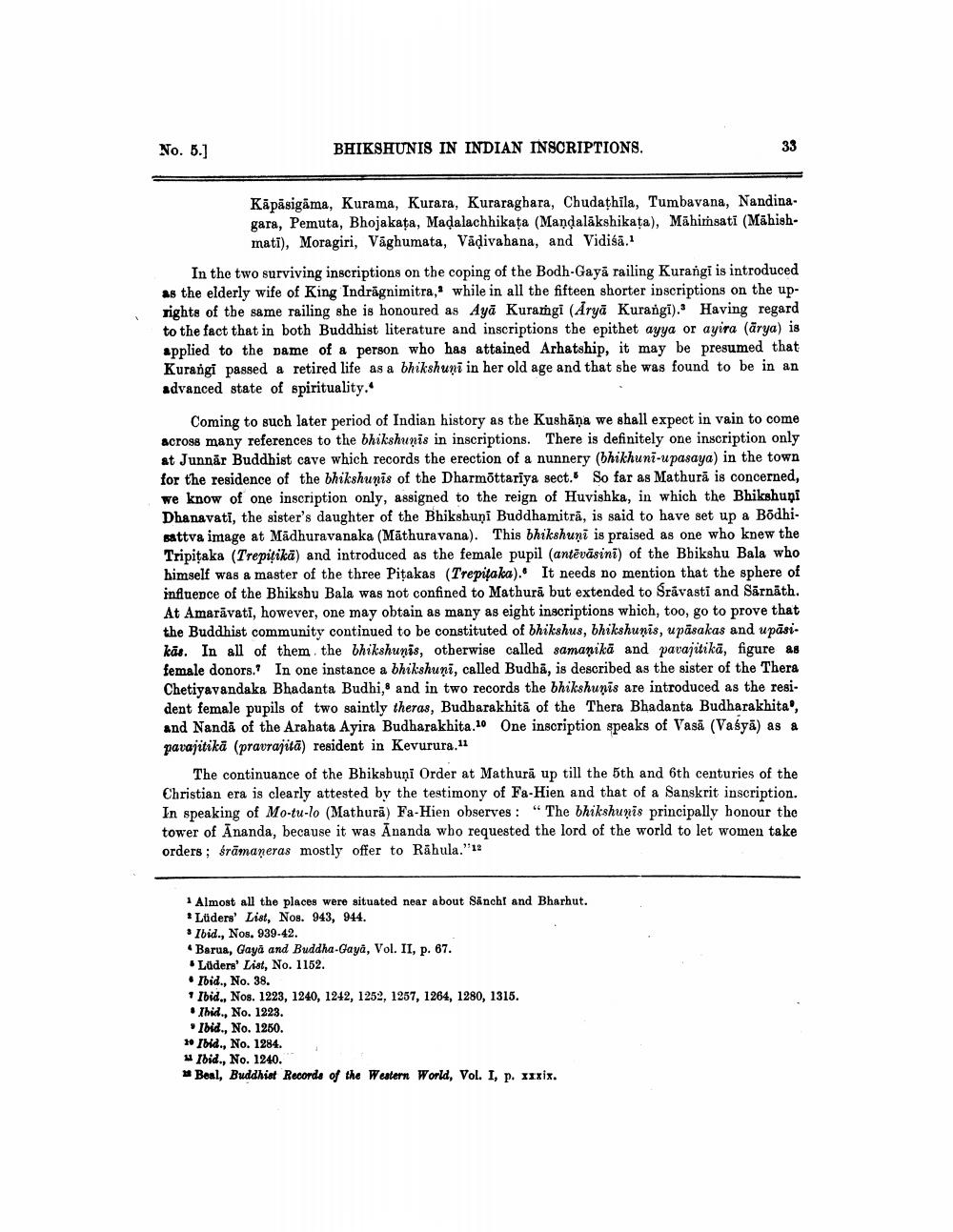________________
No. 5.)
BHIKSHUNIS IN INDIAN INSCRIPTIONS.
Kāpāsigāma, Kurama, Kurara, Kuraraghara, Chudathila, Tumbavana, Nandinagara, Pemuta, Bhojakața, Madalachhikata (Mandalākshikața), Mähimsati (Māhish
mati), Moragiri, Väghumata, Vadivahana, and Vidisā. In the two surviving inscriptions on the coping of the Bodh-Gayā railing Kurangi is introduced as the elderly wife of King Indrägnimitra,' while in all the fifteen shorter inscriptions on the uprights of the same railing she is honoured as Ayā Kurargi (Arya Kurangi). Having regard to the fact that in both Buddhist literature and inscriptions the epithet ayya or ayira (ārya) is applied to the name of a person who has attained Arhatship, it may be presumed that Kurangi passed a retired life as a bhikshuni in her old age and that she was found to be in an advanced state of spirituality.
Coming to such later period of Indian history as the Kushāna we shall expect in vain to come across many references to the bhikshunis in inscriptions. There is definitely one inscription only at Junnar Buddhist cave which records the erection of a nunnery (bhikhuni-upasaya) in the town for the residence of the bhikshunis of the Dharmõttariya sect. So far as Mathurā is concerned, we know of one inscription only, assigned to the reign of Huvishka, in which the Bhikshuņi Dhanavati, the sister's daughter of the Bhikshuni Buddhamitrā, is said to have set up a Bodhisattva image at Madhuravanaka (Mathuravana). This bhikshuni is praised as one who knew the Tripitaka (Trepitika) and introduced as the female pupil (antēväsini) of the Bhikshu Bala who himself was a master of the three Pitakas (Trepitaka).• It needs no mention that the sphere of influence of the Bhiksbu Bala was not confined to Mathurā but extended to Srävasti and Sārnāth. At Amarāvati, however, one may obtain as many as eight inscriptions which, too, go to prove that the Buddhist community continued to be constituted of bhikshus, bhikshunis, upăsakas and upāsi. kās. In all of them the bhikshunis, otherwise called samanikā and pavajitikā, figure as female donors." In one instance a bhikshuni, called Budhā, is described as the sister of the Thera Chetiyavandaka Bhadanta Budhi, and in two records the bhikshunis are introduced as the resident female pupils of two saintly theras, Budharakhita of the Thera Bhadanta Budharakhita', and Nandā of the Arahata Ayira Budharakhita.10 One inscription speaks of Vasā (Vaśyā) as a pavajitikā (pravrajitā) resident in Kevurura. 11
The continuance of the Bhiksbuni Order at Mathurā up till the 5th and 6th centuries of the Christian era is clearly attested by the testimony of Fa-Hien and that of a Sanskrit inscription. In speaking of Mo-tu-lo (Mathura) Fa-Hien observes : “The bhikshunis principally honour the tower of Ananda, because it was Ananda who requested the lord of the world to let women take orders; frāmaneras mostly offer to Rähula."12
1 Almost all the places were situated near about Sánch and Bharhut. * Lüders' List, Nos. 943, 944. • Ibid., Nos. 939-42.
Barua, Gaya and Buddha-Gaya, Vol. II, p. 67. .Lüders' List, No. 1152. • Ibid., No. 38.
Ibid., Nos. 1223, 1240, 1242, 1252, 1257, 1264, 1280, 1315. • Thid., No. 1223.
Ibid., No. 1250. * Ibid., No. 1284. 1 Ibid., No. 1240. ** Beal, Buddhist Records of the Western World, Vol. I, p. xxxix.




